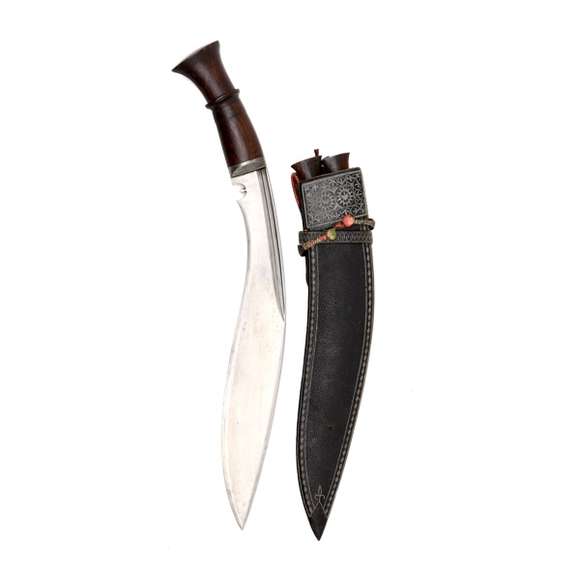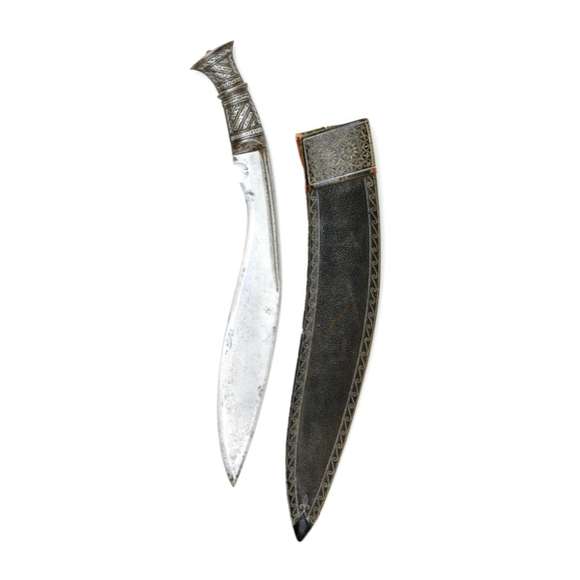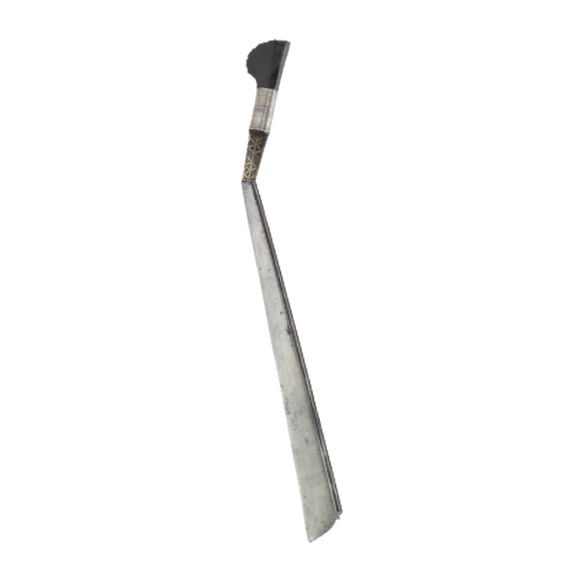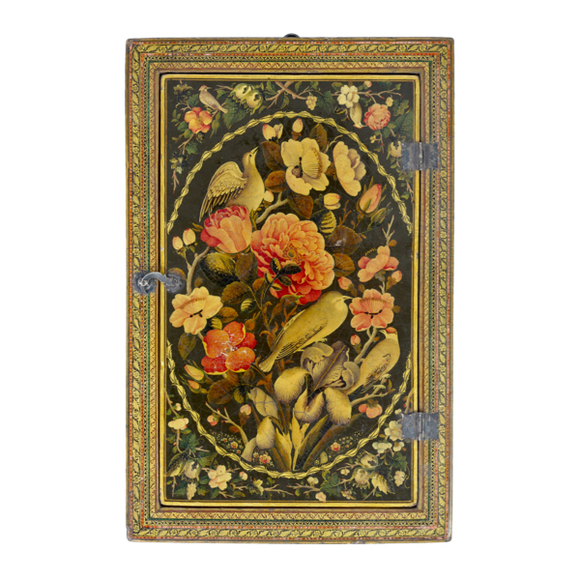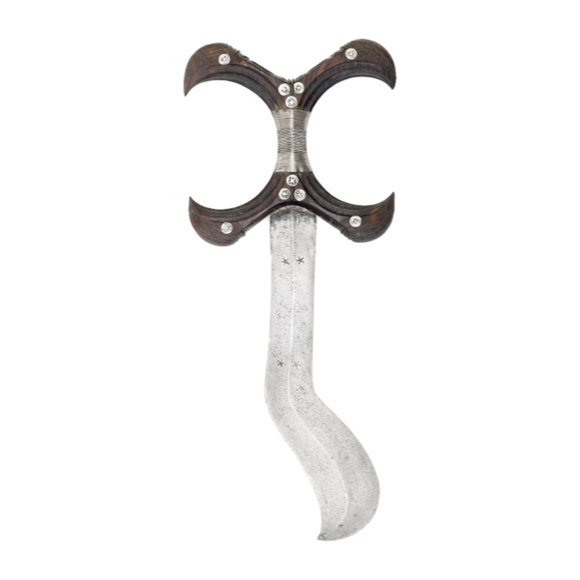An understated, elegant khukuri of substantial proportions with fine layered blade.

98.5 cm
22 x 17 cm
813 grams
Iron, wood, brass
Chota Nagpur Plateau
Eastern India
19th century
European antique art market
Introduction
The Khonds of the 19th century were a clan-based tribal people of central, eastern, and southern India. Their primary melee weapon was the axe, used in both hunting and warfare.
"The Khond usually carries a long staff, but when armed he wears a turban ornamented with a showy crest of feathers, and a strong cloth encircling his loins; he carries a bow and arrows, and a battle-axe with the blade in two divisions. He marches to battle singing, shouting, and brandishing his battle axe, most commonly under the influence of strong potations. The matchlock and shield are the favourite weapons of the people inhabiting the Southern district; but the curious and formidable battle-axe seems most relied on by the heroes of Boad and Goomsur." 1
-Major General Sir John Campbell, 1864.
"The following instance occurred to Lieut. McNeill when out bear shooting, accompanied by some Khonds, who had been rescued from sacrifice. He had posted himself in a favourable position one moonlight night, when a bear came up, but owing to the uncertain light, for the moon was not very bright, he only wounded the beast slightly; it made off at once right across the rice fields in the open plain, with the intention of seeking shelter in the neighbouring hills, without allowing time for the adjustment of the sight for a second shot.
The Khonds had started at full speed in pursuit, to cut off the animal's retreat to the hills; they soon placed themselves between the bear and the hills, and then with axe in hand they resolutely attacked him, and literally hacked him to pieces in less time than it has taken to narrate this adventure. The axes used were certainly formidable weapons, but it requires more than ordinary courage to attack a savage bear with such instruments as these, by moonlight, and on broken ground." 2
-Major General Sir John Campbell, 1864.

Notes to introduction
1. Major General Sir John Campbell; A Personal Narrative of Thirteen Years Service Amongst the Wild Tribes of Khondistan for the Suppression of Human Sacrifice, Volume 1. Hurst and Blackett, 1864.
2. See: Lord Egerton of Tatton; Indian and Oriental Arms and Armour. Dover Publications; Revised edition, 2002. Page 78. And: Stone, George C.; A Glossary of the Construction, Decoration and Use of Arms and Armor: in All Countries and in All Times. (Reprint) Jack Brussel, New York, 1961. Page 155.
This example
A very rare subtype of the Khond tribal axe. It has a bifurcated and cusped blade, sharpened on all sides save for the two rear arches. It is forged on a socket with a rib at the back, probably for less damaging warning blows in a fight that hasn't fully escalated.
It is mounted on a hardwood shaft, with a cast brass socket on top with a small spike. another cast brass sleeve is at the butt end, held in place by an iron nail and washer.
The manufacture is rather tribal, with coarse forging, but the overall design makes it an impressive piece nonetheless. There's a certain charm in its crude effectiveness.
Comparable examples
The British Royal Collection has 52 Khond axes in its database. Only one has a head shape identical to ours, and another is quite close. A similar example was presented to King Edward VII, when Prince of Wales, during his tour of India in 1875-76 by James Wood-Mason, then Assistant Curator at the Indian Museum, Calcutta. It can be found under accession number RCIN 37618. This piece is missing the top socket and spike.
James Wood-Mason was an English zoologist who became assistant curator of the Indian Museum in 1869 and became its superintendent in 1887. He sadly passed away at the young age of 47 in 1893. The Indian Museum was established in 1814 and is considered to be the oldest museum in India.
The Royal Collection Trust records mention that this axe is recorded to have been used by the peoples living in Chota Nagpur.
The British Museum has 21 Khond axes, again only one of which is an exact match to the shape of this head, and two have forms that are strongly related.
Identical is accession number As,+.2320. Its database entry says:
'India. Axe, with divided blade, with four points; iron spike at top of handle. From the Khonds. Presented by Sir John Lubbock Bart. MP. October 1884.'
Sir John Lubbock was a British banker and polymath. A friend of Charles Darwin, he occupied himself with the study of biology, archaeology and ethnography. We owe the terms "Paleolithic" and "Neolithic" to him.








With iron, silver overlaid hilt. Its associated scabbard features fine quillwork.
This peculiar sword was used by the Garo people of Assam for fighting, clearing the jungle, and animal…
Made of pasteboard, finely lacquered with roses and nightengales.
These handsome daggers were worn by the nomadic Hadendoa people, their name has been interpreted as meaning…

